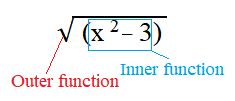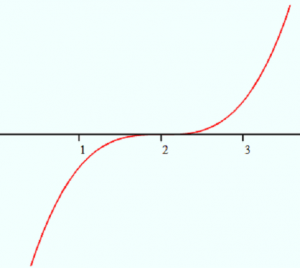Contents:
- What is a Composite Function?
- What is Decomposition?
- Identifying Function Parts
- Function Types
- Function Composition / Decomposition Example Problems
- Continuity of a Composite Function
What is a Composite Function?
A composite function is, like the name suggests, a composite (blend) of two different functions. Basically, you take one function and add on another one.

Notation
A circle is used to indicate function composition. For example, f ∘ g means that f and g are forming a composite function. Just like in order of operations (PEMDAS), order matters; The composite function f ∘ g is usually different from g ∘ f.
Although (f ∘ g)(x) is a valid way to write a composite function, you’re more likely to see it written this way in calculus: f(g(x)). The “f” is clearly on the outside, and the “g” is clearly on the inside. That’s why the two functions are often referred to as inner functions and outer functions. If you use circle notation, it isn’t always clear which function is inner and which is outer, but with the second type of notation, it’s easier to see.
The letters f and g are customary, but you might see other notation as well, such as h(x) or p(x). It’s also valid to use something other than “x” as your variable. For example, if you’re using time, you might also see f(g(x)).
Example
Example question: form a composite function from the following two functions:
- f(x) = x – 5
- g(x) = 2x + 2.
Step 1: Rewrite the expression as a composite function: f(g(x)).
Step 2: Work the inner function first, replacing g(x) with the given equation—2x + 2:
f(g(x)) = f(2x + 2)
Step 3: Insert your outer function into the expression you got in Step 2. The outer function given in the question is f(x) = x – 5, so:
(f(g(x)) = f(2x + 2) = (2x + 2) – 5
This simplifies to 2x -3.
Solution: (f ∘ g)(x) = 2x – 3
What is Decomposition?
In calculus, you usually have to deal with composite functions when you’re finding derivatives with the chain rule. Here, you’ll see one function “inside” another function, and you have to separate the two functions before you can apply the rule.
The opposite of composition is decomposition, which basically means separation. What you’re trying to do is identify the inner function and the outer function so you can pull them apart. Some functions are relatively easy to separate, while others take a little more work.
For example, √ (x2) has the outside function of the square root (√) and the inside function of x2.
For more examples, see:
Chain Rule Examples and
Identifying Functions
 In order to figure out function composition (or to decompose a function), you must be familiar with the eight common function types and with basic function transformations, like:
In order to figure out function composition (or to decompose a function), you must be familiar with the eight common function types and with basic function transformations, like:
- A negative sign flips an axis around the origin,
- Adding a constant shifts the function’s graph to the left that number of units.
Splitting a function into two can be useful if the original composite function is too complicated to work with. Composite functions are usually represented by f(x) and g(x), where f(x) is a function that takes some kind of action on g(x). For example:
f(g(x)) = -(x – 3)2 + 5
is a composite function with f(x) taking an action on g(x). The question becomes what function is f(x) and what function is g(x)?
Function Composition: Basic Function Types
Function decomposition is, in a very basic sense, splitting a complicated function into basic pieces. Those “basic pieces” are going to have one of the following eight forms. In order to be able to decompose a function, you must be able to recognize these forms.
| Function Type | Format | Which terms are constants? |
|---|---|---|
| Exponential Functions | y = a bx | a, b |
| Linear Functions | y = m x + b | m, b |
| Logarithmic Functions | y = a ln (x) + b, | a, b |
| Polynomial Functions | y = an · xn + an−1 · xn −1 +… + a2 · x2 + a1 · x + a0, | an, an − 1,… , a2, a1, a0 |
| Power Functions | y = a xb | a, b |
| Rational Functions | Ratio of two polynomial functions | Same as polynomials |
| Quadratic Functions | y = a x2 + b x + c | a,b,c |
| Sinusoidal Functions | y = a sin (b x + c), | a,b,c |
Function Composition Example Problems
Example problem 1: Identify the functions in the equation f(g(x)) = -(x – 3)2 + 5
Step 1: Identify the original function(s). The original function might be: linear, polynomial, square (quadratic), absolute value, square root, rational, sine or cosine. In this example, the original function is the square – (x – 3)2 (the square – (x – 3) has been shifted up five units).
Step 2: Write the functions using standard terminology (f(x) and g(x)).
f(g(x)) = -(x – 3)2 + 5, so:
g(x) = – (x – 3)2
f(x) = x + 5
Example problem 2: Identify the functions in the equation f(g(x)) = (x + 2 / x)3
Step 1: Look for the original function f(x)—see Step 1 of example problem 1 above. In this example, the original function isn’t an obvious example of a basic function type. However, while the function f(x) = x + 2/x isn’t a basic type, the second function g(x)—x3 is (it’s a cubic polynomial). So:
f(g(x)) = (x + 2 / x)2
f(x) = x + 2 /x
g(x) = x3
Tip: When trying to find composite functions, look for the simplest transformation, usually involving x and a cube, square, simple addition, division, multiplication, subtraction etc.. This simple transformation is either going to be f(x) or g(x).
Continuity of a Composite Function
The composite of two continuous functions is continuous.
In notation, that’s:
If a function g is continuous at x = c, and a second function f is continuous at x = g(c), then the composite function f ◦ g given by
(f ◦ g)(x) = f (g(x))
is also continuous at c.
We can also write about continuity of a composite function in terms of limits. If f is continuous at (x0, y0) and g is continuous at f(x0, y00, y0). As a limit, that’s [1]:

Example: Both f(x) = x3 + 9 and g(x) = sin(x) are continuous on the open interval (-∞, ∞). Therefore, both of the following compositions are continuous on (∞, ∞):
- (f ◦ g)(x) = sin3x + 9 , and
- (f ◦ g)(x) = sin(x3 + 9) are continuous.
Function Composition: References
[1] McGinnis, D. Math 254 ~ Functions of Several Variables. Retrieved August 16, 2021 from: https://people.math.osu.edu/mcginnis.7/11Wi%20M254/M254%20Ch13.pdf
5.2 – Reference – Graphs of eight basic types of functions.